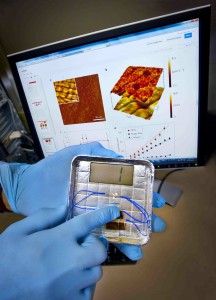Noting how much solar and wind industries have grown since President Obama entered office, he says "we must keep at it," and announced the Clean Energy Investment Initiative.
He’s looking to "catalyze $2 billion of private sector investment" to get clean energy innovations to market faster. The goal is to keep bringing down costs, while improving performance and scalability.
The Department of Energy (DOE) will lead the effort, mobilizing foundations and other impact investors to scale their investments across the energy innovation pipeline. The idea is bridge the "valley of death" – helping companies quickly get their technologies out of the lab and into the marketplace.
Lawrence Berkeley National Lab is the first to harness a virus to generate electricity:

To kick off this call to action, the White House will host a Clean Energy Investment Summit this spring, bringing together mission-oriented foundations, family offices, and institutional investors to fund the endeavor.
Some commitments have already been made:
-
University of California Board of Regents will build on its commitment to allocate at least $1 billion of its endowment and pension over five years for investments in solutions to climate change. In partnership with foundations and other large institutional investors, they will invest in promising technologies identified by DOE, getting them to commercial scale. The goal is to create a long-term innovation pipeline.
-
William and Flora Hewlett Foundation will connect investors with early-stage clean energy companies, so that a growing number of foundations and other mission-driven organizations can finance high impact technologies efficiently.
-
Schmidt Family Foundation has allocated a significant portion of its assets to impact investing to fill market gaps on climate change solutions. It will share its expertise on sourcing, vetting, and structuring impact investments, especially for pre-market technologies.
- Wells Fargo Foundation will build on its commitment of $100 million in environmental grants by 2020 – which includes the $10 million Innovation Incubator (IN2) that supports early-stage energy efficiency technologies for commercial buildings.
The Clean Energy Investment Initiative builds on existing programs:
- ARPA-E has invested $1.1 billion in over 400 potentially transformational energy technologies, and the President’s Budget calls for $325 million for the agency to keep the work going.
- DOE’s Solar Access to Public Capital working group has assembled over 300 organizations that are working together to increase solar financing through the public capital markets.
- DOE’s Loan Programs Office continues to support clean energy deployment and through co-lending it has been bringing new commercial lenders into the market.
- The Institute for Advanced Composites Manufacturing Innovation, a new public-private consortium of 122 manufacturers, universities, and non-profits, is sharing research, development and demonstration facilities at national labs and universities.
In May, Obama reached out to the private sector to scale commitments to use more renewable energy, improve energy efficiency and strengthen building codes.
